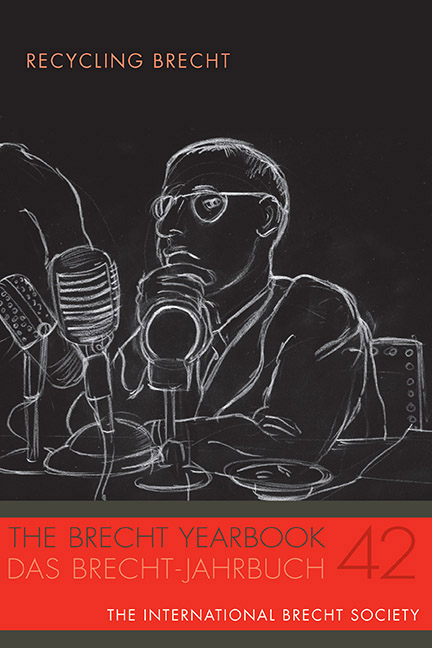Walking the Dead: George Tabori’s Reframing of Bertolt Brecht’s The Jewish Wife
Published online by Cambridge University Press: 09 April 2021
Summary
The one-act play Die jüdische Frau (The Jewish Wife), a scene from Bertolt Brecht's Furcht und Elend des Dritten Reiches (Fear and Misery of the Third Reich), is generally considered an exemplar of Brecht's Epic Theater. Elements of distanciation include the poetic commentary preceding the scene, the extended pantomime at its outset, the one-sided phone conversations the audience witnesses, and the wife's rehearsal of the discussion with her husband prior to his arrival and its subsequent repetition. Set in 1935, the year of the passage of the Nuremberg racial laws, laws that “would provide the legal framework for the systematic persecution of Jews in Germany,” the scene shows Judith Keith packing her suitcase, preparing for her initial exile in Amsterdam. She does so to alleviate the political pressure on her gentile husband, a chief surgeon at a Frankfurt hospital whose job is threatened by his marriage to a Jew. To her friends and relatives, Judith's departure is presented as a short sojourn, though everyone, including her husband, knows that her leave is of a more permanent nature. Both the acquiescence to the political developments in this upper-bourgeois household and the charade put up to veil this fact are cruelly exposed in this scene, which highlights the combination of fear and deceit that characterizes the existence under the totalitarian regime.
Die jüdische Frau is one of twenty-seven scenes Brecht wrote in 1937–38 depicting everyday life in Nazi Germany, and it is one of the few instances in which Brecht addressed Jewish persecution under National Socialism. Even then, however, he is not primarily interested in Nazi racial policies targeting German Jews as a separate group, but in the mechanisms of fascism as pertaining to the German bourgeoisie. As John J. and Ann White have observed, for Brecht, anti-Semitism was “a politically functional phenomenon,” an ideological tool to deflect from class conflict. Die jüdische Frau consequently depicts the persecution of German Jews in the context of “the capitulation of bourgeois intellectuals” and, pointing to the lack of active resistance, of their complicity in the rise of National Socialism.
In its attempt to document everyday life in Nazi Germany, Furcht und Elend des Dritten Reiches is, perhaps, unique among Brecht's dramatic works, in that it presents the author's critique in historically and socially realistic settings rather than in temporally removed locales or in parable form.
- Type
- Chapter
- Information
- The Brecht Yearbook / Das Brecht-Jahrbuch 42Recycling Brecht, pp. 103 - 120Publisher: Boydell & BrewerPrint publication year: 2018



